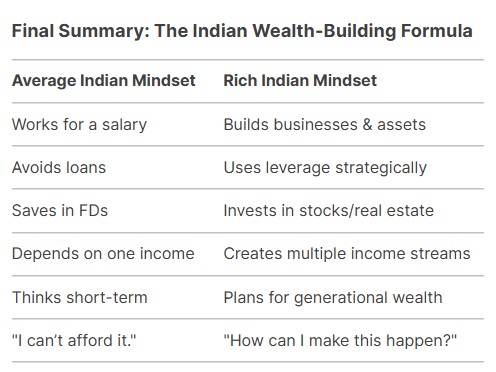Rich vs Poor and Wealthy Indians from industrialists to startup founders don’t just earn money; they multiply it through smart strategies, calculated risks, and long-term thinking. Below is a detailed breakdown of how India’s richest build wealth, with real-world examples and powerful quotes.
1. Rich Focus on Assets, Not Just Income
Wealthy Indians prioritize buying assets (businesses, stocks, real estate) over-relying on salaries.
- Example:
- Ratan Tata didn’t just inherit wealth—he expanded the Tata Group by acquiring Jaguar Land Rover, Tetley, and Corus Steel, turning them into profit-generating assets.
- Radhakishan Damani (DMart founder) invested in real estate and equities, making him a billionaire beyond retail.
Quote:
“Don’t work for money, make money work for you.” — Warren Buffett
Key Takeaway:
- Average Indian: “How can I get a higher salary?”
- Rich Indian: “How can I own income-generating assets?”
2. Rich Use Leverage (OPM—Other People’s Money)
Rich Indians use loans, investors, and partnerships to scale faster.
- Example:
- Mukesh Ambani raised billions from global investors (Facebook, Google) for Jio instead of funding it all himself.
- Real estate tycoons (like DLF, Sobha) use bank loans to develop projects, selling them before repayment deadlines.
Quote:
“If you owe the bank 100, that’s your problem.If you owe the bank 100, that’s your problem.Ifyouowethebank100 million, that’s the bank’s problem.” — J.P. Morgan
Key Takeaway:
- Middle-Class: “I’ll save for 20 years to buy a house.”
- Rich: “I’ll get a loan, rent it out, and let tenants pay my EMI.”
3. Rich Think Long-Term & Compound Wealth
Patience + reinvestment = explosive growth.
- Example:
- Azim Premji held Wipro shares for decades, turning a small vegetable oil company into a $40B+ IT empire.
- Early investors in Infosys, TCS, or Reliance saw 100x+ returns by holding stocks for 20+ years.
Quote:
“The stock market is a device for transferring money from the impatient to the patient.” — Warren Buffett
Key Takeaway:
- Average Investor: “I want quick profits from trading.”
- Rich Investor: “I’ll buy and hold great businesses for decades.”
4. Multiple Income Streams = Safety + Growth
The wealthy never depend on just one source.
- Example:
- Shah Rukh Khan earns from movies, IPL (Kolkata Knight Riders), brand endorsements, and real estate.
- Nandan Nilekani (Infosys co-founder) invests in startups (like Zerodha) beyond his core business.
Quote:
“Don’t put all your eggs in one basket.” — Indian proverb (followed by smart investors)
Key Takeaway:
- Salaried Employee: “My job is my only income.”
- Rich: “I have dividends, rent, business profits, and royalties.”
5. Solve Big Problems = Big Rewards
Scaling solutions for India’s masses creates massive wealth.
- Example:
- Dhirubhai Ambani made telecom affordable with Reliance Communications.
- Vijay Shekhar Sharma (Paytm) revolutionized digital payments in India.
Quote:
“If you solve a problem for millions, money follows automatically.” — Kunal Bahl
Key Takeaway:
- Middle-Class: “I’ll open a small shop.”
- Rich: “How can I disrupt an entire industry?”
6. Network with the Right People
Your circle influences your success.
- Example:
- Ratan Tata mentors startups (Ola, CureFit) and gains early investment opportunities.
- Anand Mahindra collaborates with global giants (Ford, Tesla) for joint ventures.
Quote:
“Your network is your net worth.” — Porter Gale (practiced by Indian biz leaders)
Key Takeaway:
- Average Person: “I don’t need connections.”
- Rich: “I actively seek mentors and partners.”
7. Never Stop Learning
The rich adapt to new trends (tech, markets, policies).
- Example:
- Rakesh Jhunjhunwala studied annual reports like a monk before investing.
- Nithin Kamath (Zerodha) educated retail investors via “Varsity” before scaling his brokerage.
Quote:
“An investment in knowledge pays the best interest.” — Benjamin Franklin (quoted by Indian investors)
Key Takeaway:
- Poor: “I don’t have time to learn.”
- Rich: “I spend 1 hour daily mastering finance & trends.”
8. Take Smart Risks (Not Gambles)
Wealthy Indians assess risk vs. reward carefully.
- Example:
- Sunil Mittal (Airtel) bet on mobile telephony when few believed in it.
- Biyani (Future Group) expanded retail despite early failures.
Quote:
“Big risks = big rewards, but only if calculated.” — Radhakishan Damani
Key Takeways
- Risk-Averse: “What if I fail?”
- Rich: “What’s the worst-case scenario, and how do I manage it?”
9. Tax Optimization & Legal Structures
Smart structuring saves crores legally.
- Example:
- Startup founders register in GIFT City (tax benefits).
- Family businesses use trusts to reduce inheritance tax.
Quote:
“It’s not how much you earn, but how much you keep.” — Robert Kiyosaki
Key Takeaway:
- Salaried Employee: “I pay 30% tax and complain.”
- Rich: “I use HUF, LTCG, and biz expenses to minimize tax.”
10. Abundance Mindset
The rich see opportunities where others see lack.
- Example:
- Narayana Murthy started Infosys with ₹10,000—today it’s worth ₹6 lakh crore+.
- Falguni Nayar (Nykaa) left banking at 50 to build a beauty empire.
Quote:
“If you think you can, or you think you can’t—you’re right.” — Henry Ford (believed by Indian entrepreneurs)
Key Takeaway:
- Scarcity Mindset: “Money is hard to earn.”
- Abundance Mindset: “Wealth is everywhere—I just need the right strategy.”

Action Step:
Start with one strategy—invest in SIPs, network with successful people, or start a side hustle. As Ratan Tata says:
“Take the stones people throw at you, and use them to build a monument.”
Other article: Why Gold Allocation is Essential for Your Investment Portfolio?


